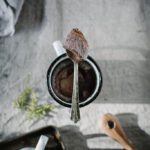Hello, hello! It’s your devoted herbalist Lauren Haynes of Wooden Spoon Herbs. Today we’re chatting about immunity, as we’re in the midst of cold weather season in the northern hemisphere (though southern hemisphere friends can take heed as well)! I’ve also got a recipe for what I’m calling Zippy Cider. It’s my riff on the classic Fire Cider that has a long-standing reputation for stopping a cold in its tracks!
What causes our immunity to breakdown?
Maybe your kids are back to school, or you’re overwhelmed by the stress of holiday prep, work deadlines are closing in fast, or you’re spending more time in densely populated places like subways and airports. On top of it all, this is the time of year that people tend to drink more alcohol, which isn’t a friend of the immune system.
When stress is high, our bodies produce more and more stress hormones, which can suppress the effectiveness of the immune system. Combine that with cold and flu season, and it is no wonder people spend so much time feeling crummy during the colder months.
The good news is that there are so many ways we can support our immunity through the seasonal rollercoaster! Let’s dive in and take a look at what that means, what those ways might be, and how plants can support our innate immunity and be natural remedies for fighting the cold and flu.
Everyday Herbs for Immune Support
Immunomodulators are herbs that modulate the immune system. If there’s an invader, they send in the cavalry. If there’s too much action, like with an autoimmune disorder, they turn the volume down. Immunomodulators are the kinds of herbs you want to take every day for overall immune support. Think elderberry, medicinal mushrooms, astragalus, codonopsis, ginseng, holy basil, and ashwagandha. You can take these any way you’d like, from holy basil tea to mushrooms simmering in a stew to capsules of ashwagandha.
Herbs for When You Feel a Cold Coming On
Immune stimulants are the herbs that you need when you can see that cold cresting the horizon. You want to fend it off and herbs are the perfect natural remedies for fighting a cold or the flu! Get the immune cells in formation. Immune stimulants are most useful when you are on the brink of taking a day off work, and you need some extra support. They’re often referred to as “immune boosters.” The most famous immune stimulant is echinacea, but there’s also goldenseal, spilanthes, garlic, honeysuckle, and usnea.
Herbs For Feeling Better, Sooner
Okay, let’s say you’re already under the weather. Antimicrobials are herbs that help kill off unwanted pathogens or stop their growth. They’re so easy to get into your lifestyle because most of them live in the kitchen cupboard! Crack open your spice drawer, and you’ll find some of the best plants to support immunity. And it makes sense. These herbs are traditionally used to preserve food by keeping pathogens away. We’re talking black pepper, salt, sage, garlic, ginger, cayenne, rosemary, thyme, cinnamon, clove, and then less spicy herbs like goldenseal, elderberry, wild bergamot, honeysuckle, juniper, yarrow, and chamomile.
To help guide you on your immune-boosting journey, I’m sharing a recipe with you for my Zippy Fire Cider, named for the zip and zing you’ll feel when it’s on its way down! It’s my take on fire cider, is infinitely customizable, and is a riff on the classic recipe by herbal godmother Rosemary Gladstar. But first, what IS fire cider anyway?
What is fire cider?
Developed by Rosemary Gladstar in the 70s, fire cider always starts with apple cider vinegar, which is a fermented ingredient that has antibacterial and antioxidant properties. From there, you begin adding other ingredients like horseradish (helps with decongestion) or garlic and onions (for antibacterial support), and let it sit and infuse for at least two weeks or up to a month! Once it has steeped for the necessary time, you add in a healthy serving of honey to make it go down easier!
Fire cider has been touted for boosting energy, staving off colds and the flu, curbing cravings, aiding in digestion, and easing congestion. This is a natural system restorer and invigorator!
How do I take fire cider and how much?
- Take a shot of it daily (this is why the honey is important!)
- Sprinkle it over cooked greens
- Add an ounce or so to a sparkling water or soda with ice
- Mix into your daily smoothie or juice
- Combine with a nice olive oil for a spicy vinaigrette
- The possibilities are endless!
As for dosage, I would say keep it to 3 ounces or less a day. Just think of it as vinegar, and use it in the instances and amounts you would use vinegar.
The best source for herbs is your local farmer’s market or herb shop, but you can also order online from a supplier with integrity, like Mountain Rose Herbs.

Zippy Fire Cider
Ingredients
- 1 medium onion red or white, sliced into half-moons
- 4-5 cloves of garlic smashed and roughly chopped
- 2 knob of ginger roughly chopped or sliced thin
- 1 lemon sliced into thin rounds
- 3-4 tablespoons fresh horseradish grated (optional)
- 2 teaspoons thyme leaves minced
- 2 teaspoons oregano minced
- 1 teaspoon lavender pods
- Tiny pinch of cayenne pepper
- 32 ounces raw apple cider vinegar Bragg’s is a good go-to!
- 1/2 cup honey optional (added after infusion period)
- 1- quart jar
Instructions
- Sterilize a quart-sized glass mason jar by boiling or putting it in the dishwasher. Set this aside. Prepare the garlic, ginger, horseradish, and onions as specified above. You can keep any skins on; we’ll strain them out later. Add to your jar. Mince the herbs and add with the lavender and cayenne to your jar as well.
- Gently warm the apple cider vinegar over the stove, being careful not to let it boil, lest you destroy its live enzymes. Pour the heated vinegar into your quart jar over the herbs. The warmth helps it draw out all the plants’ properties.
- Cover the entire mixture with a piece of parchment paper and then screw on the lid tightly. Shake vigorously. Label this steeping concoction with the name of the potion (Zippy Cider), the ingredients, the date you started the steeping, and maybe the end date just to avoid any mental math down the road.
- Let it sit in a cool dark place for two weeks, or up to a month. Shake daily and infuse it with your intentions! Traditionally, fire cider is buried in a hole in the earth and left to soak up the planetary vibes for a full moon cycle. You can totally do this, too!
- After at least two weeks, strain out the solids, compost them and bottle your vinegar. You can add raw honey and sweeten to taste. It’s so good! I usually add about a half cup of honey to the quart. It will keep for many months and does not need to be refrigerated.
Notes
My name is Beth, Elizabeth Evelyn to be exact. A native Tennessean, I was born in the South.
I am the author behind Local Milk Blog.







